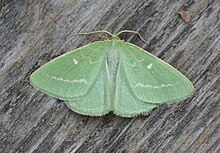Essex emerald
| Essex emerald | |
|---|---|

| |

| |
| Scientific classification | |
| Domain: | Eukaryota |
| Kingdom: | Animalia |
| Phylum: | Arthropoda |
| Class: | Insecta |
| Order: | Lepidoptera |
| Family: | Geometridae |
| Subfamily: | Geometrinae |
| Tribe: | Comibaenini |
| Genus: | Thetidia |
| Species: | T. smaragdaria |
| Binomial name | |
| Thetidia smaragdaria (Fabricius, 1787) | |
| Synonyms | |
| |
The Essex emerald (Thetidia smaragdaria) is a moth of the family Geometridae. The species was first described by Johan Christian Fabricius in 1787 as Phalaena smaragdaria.[1] It is distributed throughout the Palearctic region with records from many European countries. The British subspecies Thetidia smaragdaria maritima was last seen in 1991 in Kent and is now presumed extinct.[2] In 2004 the moth was first recorded from Sweden.

The wingspan is 27–35 mm. There is one generation per year with adults on wing from mid-June to mid-July.
The larvae feed on Artemisia maritima and Achillea millefolium. Larvae can be found from July to June the following year. It overwinters in the larval stage.
Subspecies
- Thetidia smaragdaria smaragdaria
- Thetidia smaragdaria gigantea Milliere, 1874
- Thetidia smaragdaria maritima Prout, 1935
- Thetidia smaragdaria volgaria Guenee, 1858
References
- ^ "Thetidia smaragdaria (Fabricius, 1787)". www.gbif.org. Retrieved 2022-03-17.
- ^ "Essex Emerald".
External links
